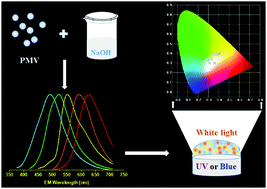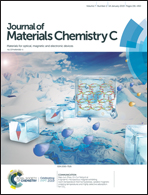New multicolored AIE photoluminescent polymers prepared by controlling the pH value†
Abstract
A new type of multicolored AIE photoluminescent polymers prepared by controlling the pH-value is reported in this paper. Our new finding shows that pH-value can affect the aggregation of poly(maleic anhydride-alt-vinyl acetate) (PMV) derivatives in aqueous solution. Based on this new finding, a new group of low-cost AIE photoluminescent PMV derivatives with tunable emission from cyan to red were prepared by simply mixing PMV with different concentrations of NaOH aqueous solution. The yellow photoluminescent derivative has been found to have a similar emission with YAG:Ce, a common rare earth phosphor for White light-emitting diodes (WLEDs). A pure white emission with a Commission International de l’Eclairage 1931 of (0.33, 0.34) can be obtained by combining yellow emission derivative with a blue LED chip. WLEDs with a controllable correlated color temperature from cold white (7215 K) to warm white (3486 K) can be fabricated with the new PMV derivatives coated on UV or blue LED chips. This is the first report of AIE photoluminescent polymers that can replace the rare-earth coating on LED chips for White light-emitting diodes (WLEDs). Besides, the new group of low-cost AIE photoluminescent PMV derivatives with tunable emission can also be used as fluorescent dyes for polymer films, fibers and hydrogels with different colors.



 Please wait while we load your content...
Please wait while we load your content...